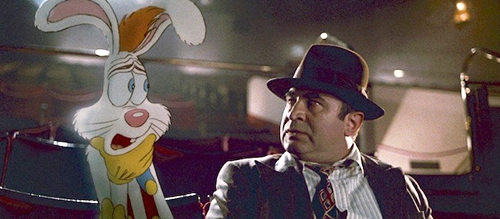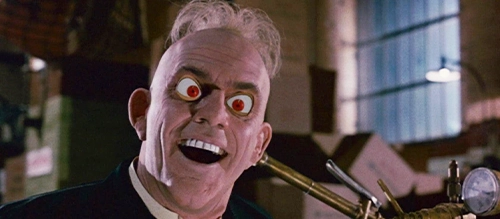‘Who Framed Roger Rabbit’ at 35 – Review

Who Framed Roger Rabbit (1988)
Director: Robert Zemeckis
Screenwriters: Jeffrey Price, Peter S. Seaman
Starring: Bob Hoskins, Charles Fleischer, Alan Tilvern, Stubby Kaye, Kathleen Turner, Christopher Lloyd, Lou Hirsch
Jaded, scotch-swilling private eye Eddie Valiant (Bob Hoskins) is embroiled in a story of adultery and murder in this classic Touchstone Pictures film… for children. While it doesn’t sound like the best premise for a PG feature, Who Framed Roger Rabbit became an instant classic.
Valiant lives in a world where cartoon characters are as real as he is, mixing animation and live action like other childhood gems such as Pete’s Dragon (1977) and Bedknobs and Broomsticks (1971). There is something magical and appealing about combining the real world with everyone’s favourite cartoon characters. It’s the Toy Story principle: ‘what if those pretend things I love come alive?’ And, because so few of these mixed-media films followed Who Framed Roger Rabbit, it remains the pinnacle of the genre.
Cartoon rabbit Roger (Charles Fleischer) is a beloved network star, so when he is framed for murder, his boss R.K. Maroon (Alan Tilvern) wants his name cleared. Valiant is called in to uncover the sordid truth, and it doesn’t take long for the equal parts infuriating and loveable bunny to get under his skin. Eddie’s journey from embittered soul to reluctant hero is as wholesome as any Disney jape.
Valiant’s deep distrust of the toons he shares a life with adds a palpable tension between the characters, and it is this tension that drives the story. Eddie’s averseness to being involved with the community he associates with his brother’s death makes it more satisfying when Roger wins him over. Who Framed Roger Rabbit is the ultimate buddy movie, something that director Robert Zemeckis explores frequently in his films – from Doc and Marty in Back to the Future to Chuck and Winston in Cast Away, Zemeckis is a dab hand at exploring non-traditional friendships with warmth and feeling.
Its eighties aura and forties setting do mean that quite a percentage of Who Framed Roger Rabbit might not quite stand up to modern-day scrutiny. Particularly its portrayal of women. Jessica Rabbit (played by the bizarrely uncredited Kathleen Turner), for instance. Based on forties bombshells, she makes Barbie dolls look like an attainable body type. Her flagrant sensuality is a lot to handle, especially when you consider that in this world of toons and people someone invented her purely for entertainment. But deep down she’s a golden-hearted broad who just loves a funny guy. She’s not bad, she was just drawn that way.

Modern parents might well wince at the humour and innuendo. As with all animated films, many jokes are intended for the adults, sailing over the heads of the younger audience members. Who Framed Roger Rabbit pushes that to its limit. Jibes about sexual proclivity, prostate problems, and alcoholism can all be found in abundance. “Bitch” and “bastard” make an appearance, as does cartoon violence that goes far beyond slapstick. But Incredibles 2 (2018) had a brainwashed mother attack her baby so kids can cope with a bit of darkness in their art.
The adult themes and classic film noir tropes knit seamlessly with those more expected of a family film. The presence of the cartoons literally brightens up the dank back-alley bars. Long reaching shadows, blackmail, damsels in distress, a 40s setting, innocent people accused of a crime. They’re all there. Allusion, rather than graphic depiction, is another trope often used in film noir that works in a children’s film. And flawed heroes with crosses to bear. Eddie Valiant is definitely an anti-hero, but in all the right ways. Much like Disney’s Robin Hood, a fox who does so many bad things but for all the right reasons.
While the hero of the film is nuanced and complicated. The villain is clear. Christopher Lloyd – who previously worked with director Robert Zemeckis on Back to the Future (1985)– is impeccable with his truly unhinged Judge Doom. He is perhaps one of the greatest movie villains of all time. Lloyd doesn’t blink once while on screen. His tightrope walk between comedy and horror, veering wildly between the two, is mesmerising.
Well received by critics and audiences alike, Who Framed Roger Rabbit was the second highest-grossing film of 1988, winning many of the awards it was nominated for – including (unsurprisingly) the BAFTA and Oscar for Best Visual Effects and the Academy’s Special Achievement Award. With its extended metaphor about how society treats those who are ‘other’, it remains relevant today. So, in some respects the film may seem dated with its leering male gaze (in itself arguably satire), but in others it remains a trailblazer, meaning the unforgettable pairing of Bob Hoskins and a cartoon rabbit is still very much worth a watch.
Score: 19/24

